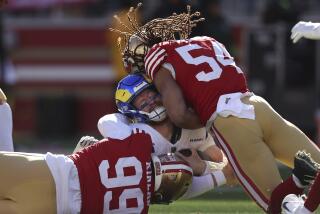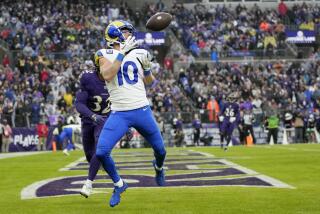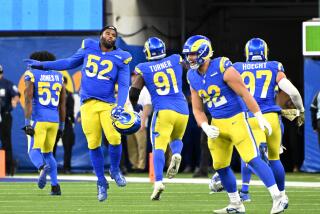SUPER BOWL XXVI / WASHINGTON REDSKINS 37, BUFFALO BILLS 24 : PRO FOOTBALL / BOB OATES : Rypien Eventually Comes Through Under Pressure
MINNEAPOLIS — In Super Bowl XXVI, the Buffalo Bills came out in a creative new defense that Washington Redskin quarterback Mark Rypien couldn’t quite solve Sunday night during a scoreless first quarter.
The Bills slipped nose tackle Jeff Wright back a step, nearly as a linebacker, and bunched their defensive ends--taking away the Redskin running game. At the same time, their linebackers blitzed Rypien repeatedly, ruining his aim and, for a while, his interest in passing.
This was a game that, in the end, the Redskins won easily, 37-24, but the score was only 10-0 eight minutes before halftime, and the Bills, up to that point, had been regularly stopping Washington’s running backs and hassling Rypien.
He hadn’t been bothered much that way this season. He had been sacked only nine times in 16 games--and as a consequence, he had time to pass as his team won game after game.
Could he pass effectively while taking heavy punishment from the AFC champions?
That was the question of this game when it was still on the line.
And it turned out that he could.
It was third and nine when Rypien made the game’s decisive play. Blitzed as usual, he stepped forward into the teeth of the rush and passed to wide receiver Gary Clark.
A 34-yard pass play, it put the ball on the Buffalo 15, leading to a touchdown and a 17-0 lead. It might have convinced the Bills that they weren’t going to beat this quarterback.
Stepping up in the pocket against a penetrating rush is the last thing a passer really wants to do. Thus in doing it then, and repeatedly thereafter, Rypien suggested that he is more than merely an accurate passer.
Don’t blame Kelly: It often seemed as if Buffalo quarterback Jim Kelly was having an off day, but that was basically an illusion--even when he was throwing his four interceptions.
Kelly was a victim of selected Redskin blitzing--as commanded at all the appropriate times by Washington’s defensive coach, Richie Petitbon.
The play that opened the second half illustrated the whole of Petitbon’s special Kelly defense.
The Bills were then 17 points behind, but Kelly and his no-huddle offense are capable of making that up in a hurry. On the first play after halftime, he dropped back to pass.
At that moment, a blitzing linebacker, second-year player Andre Collins, cut through to greet him as Kelly threw the ball.
As a result the pass was a few inches short of tight end Keith McKeller, and, sprinting in, linebacker Kurt Gouveia intercepted and ran it back to the Buffalo two-yard line. The Redskins scored on the next play to lead, 24-0.
It wasn’t merely another blitz that Petitbon ordered that time. It was a tricky, up-the-middle blitz by an outside linebacker, who looped inside. As Collins looped in, two of his teammates, both linemen, blocked out a guard and the center to make him a path.
A play that Petitbon has used before, but not often, it surprised Kelly. A few minutes later in the third quarter, Petitbon surprised him again with a blitz that was entirely different, prompting Kelly to fumble the ball away.
That time, two Redskins, cornerback Alvoid Mays and linebacker Wilber Marshall, blitzed Kelly side by side.
Outnumbered there, the Bills could only watch helplessly as Mays sacked Kelly into the error.
The Redskins are that kind of team. Petitbon is that kind of coach.
The NFC decade: And so an AFC team lost again. The Redskins made it eight in a row for the NFC, and 10 of the last ll.
Is the NFC that good?
Perhaps not. Perhaps two coaches are that good--Joe Gibbs of the Redskins and Bill Walsh, the former leader of the San Francisco 49ers.
Together, Gibbs and Walsh have accounted for seven of the NFC’s 10 victories, Gibbs getting his third Sunday. In his 49er days, Walsh coached three Super Bowl winners, and then, when he retired, left the club with the same team and coaching staff that carried on to win one more.
The other NFC victories in the Super Bowl’s last decade were the work of two other coaches, Bill Parcells, who twice led the New York Giants to the NFC championship, and Mike Ditka of the Chicago Bears.
But these might have been the NFC’s only successes if Gibbs and Walsh had stayed in the AFC, where they started. Both were with the San Diego Chargers as younger coaches, and Walsh was an assistant for many years in the Paul Brown organization in Cincinnati.
If Gibbs and Walsh had stayed over there, the AFC, conceivably, would be 16-4 in the last 20 Super Bowls. It was 8-1 when they began their run.
Fully equipped: For the Redskins, the next question is whether they are about to launch a Super Bowl dynasty.
They seem the one team best equipped to think about that--the one team with enough youth, enough defense, enough coaching and enough quarterback.
At 29, Rypien is only now completing his first good full season in pro football.
He was hard to figure in his first four NFL years, because he isn’t a picture quarterback.
A trifle clumsy and not noted for mobility, Rypien came into Super Bowl XXVI with a reputation for leadership and passing accuracy, and he leaves it with a reputation for playing well under pressure.
Those are all quarterback pluses that should keep him going for many years. For his long suit is the long ball. He could become, in the years ahead, the best long passer in NFL history.
The one he threw to Gary Clark for a 30-yard touchdown, making the score 31-10 during the third quarter, was typical of the best that any long passer can do. It was a deep corner pass with Rypien’s trademark touch--thrown out for Clark to run under it.
At 6 feet 4 and 234 pounds, Rypien is built like a linebacker, yet he makes a mathematician’s near-perfect decisions on where to put the ball in the defensive maze.
But where his long-ball passing touch comes from is a mystery. Canadian-born, he was apparently born with a talent that few others have ever had.
Joe Montana has that kind of touch at the middle ranges. Joe Namath had it a few yards farther down the field. Rypien can drop in a touch pass at 50 paces.
Any good athlete can make the ball go 50 yards, but probably no passer since Norm Van Brocklin has shown the ability to make it go 50 yards with great accuracy and drop like a feather.
This is a young man with a bright future.
More to Read
Go beyond the scoreboard
Get the latest on L.A.'s teams in the daily Sports Report newsletter.
You may occasionally receive promotional content from the Los Angeles Times.










